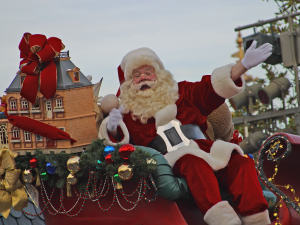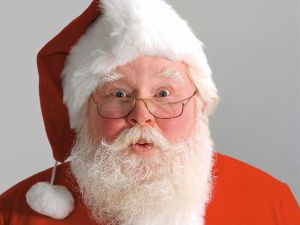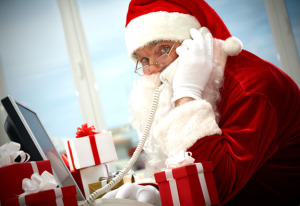 Santa Claus, also known as Saint Nicholas, Father Christmas, Kris Kringle and simply “Santa”, is a figure with legendary, historical and folkloric origins who, in many Western cultures, is said to bring gifts to the homes of the good children on 24 December, the night before Christmas Day. However, in some European countries children receive their presents on St. Nicholas’ Day, 6 December.
Santa Claus, also known as Saint Nicholas, Father Christmas, Kris Kringle and simply “Santa”, is a figure with legendary, historical and folkloric origins who, in many Western cultures, is said to bring gifts to the homes of the good children on 24 December, the night before Christmas Day. However, in some European countries children receive their presents on St. Nicholas’ Day, 6 December.
The modern figure of Santa Claus is derived from the Dutch figure of Sinterklaas, whose name is a dialectal pronunciation of Saint Nicholas, the historical Greek bishop and gift-giver of Myra. During the Christianization of Germanic Europe, this figure may have absorbed elements of the god Odin, who was associated with the Germanic pagan midwinter event of Yule and led the Wild Hunt, a ghostly procession through the sky. Over time, traits of this character and the British folklore character Father Christmas merged to form the modern Santa Claus known today.
Santa Claus is generally depicted as a portly, joyous, white-bearded man—sometimes with spectacles—wearing a red coat with white collar and cuffs, white-cuffed red trousers, and black leather belt and boots and who carries a bag full of gifts for children. Images of him rarely have a beard with no moustache. This image became popular in the United States and Canada in the 19th century due to the significant influence of the 1823 poem “A Visit From St. Nicholas” and of caricaturist and political cartoonist Thomas Nast. This image has been maintained and reinforced through song, radio, television, children’s books and films.
Since the 20th century, in an idea popularized by the 1934 song “Santa Claus Is Coming to Town”, Santa Claus has been believed to make a list of children throughout the world, categorizing them according to their behavior (“naughty” or “nice”) and to deliver presents, including toys, and candy to all of the well-behaved children in the world, and sometimes coal to the naughty children, on the single night of Christmas Eve. He accomplishes this feat with the aid of the elves who make the toys in the workshop and the flying reindeer who pull his sleigh. He is commonly portrayed as living at the North Pole and saying “ho ho ho” often.
History:
Origins:
Pre-modern representations of the gift-giver from church history and folklore, notably St Nicholas and Sinterklaas, merged with the English character Father Christmas to create the character known to Americans and the rest of the English-speaking world as Santa Claus.
In the English and later British colonies of North America, and later in the United States, British and Dutch versions of the gift-giver merged further. For example, in Washington Irving’s History of New York (1809), Sinterklaas was Americanized into “Santa Claus” (a name first used in the American press in 1773) but lost his bishop’s apparel, and was at first pictured as a thick-bellied Dutch sailor with a pipe in a green winter coat. Irving’s book was a lampoon of the Dutch culture of New York, and much of this portrait is his joking invention.
Traditions and Rituals:
Chimney Tradition:
The tradition of Santa Claus entering dwellings through the chimney is shared by many European seasonal gift-givers. In pre-Christian Norse tradition, Odin would often enter through chimneys and fire holes on the solstice. In the Italian Befana tradition, the gift-giving witch is perpetually covered with soot from her trips down the chimneys of children’s homes. In the tale of Saint Nicholas, the saint tossed coins through a window, and, in a later version of the tale, down a chimney when he finds the window locked. In Dutch artist Jan Steen’s painting, The Feast of Saint Nicholas, adults and toddlers are glancing up a chimney with amazement on their faces while other children play with their toys. The hearth was held sacred in primitive belief as a source of beneficence, and popular belief had elves and fairies bringing gifts to the house through this portal. Santa’s entrance into homes on Christmas Eve via the chimney was made part of American tradition through the poem “A Visit from St. Nicholas” where the author described him as an elf.
Christmas Eve Rituals:
 In the United States and Canada, children traditionally leave Santa a glass of milk and a plate of cookies; in Britain and Australia, he is sometimes given sherry or beer, and mince pies instead. In Sweden and Norway, children leave rice porridge. In Ireland it is popular to give him Guinness or milk, along with Christmas pudding or mince pies.
In the United States and Canada, children traditionally leave Santa a glass of milk and a plate of cookies; in Britain and Australia, he is sometimes given sherry or beer, and mince pies instead. In Sweden and Norway, children leave rice porridge. In Ireland it is popular to give him Guinness or milk, along with Christmas pudding or mince pies.
In Hungary, St. Nicolaus (Mikulás) comes on the night of 5 December and the children get their gifts the next morning. They get sweets in a bag if they were good, and a golden colored birch switch if not. On Christmas Eve “Little Jesus” comes and gives gifts for everyone.
In Slovenia, Saint Nicholas (Miklavž) also brings small gifts for good children on the eve of 6 December. Božiček (Christmas Man) brings gifts on the eve of 25 December, and Dedek Mraz (Grandfather Frost) brings gifts in the evening of 31 December to be opened on New Years Day.
New Zealander, British, Australian, Irish, Canadian and American children also leave a carrot for Santa’s reindeer, and were traditionally told that if they are not good all year round, that they will receive a lump of coal in their stockings, although this practice is now considered archaic. Children following the Dutch custom for sinterklaas will “put out their shoe”—that is, leave hay and a carrot for his horse in a shoe before going to bed—sometimes weeks before the sinterklaas avond. The next morning they will find the hay and carrot replaced by a gift; often, this is a marzipan figurine. Naughty children were once told that they would be left a roe (a bundle of sticks) instead of sweets, but this practice has been discontinued.
Other Christmas Eve Santa Claus rituals in the United States include reading A Visit from St. Nicholas or other tale about Santa Claus, watching a Santa or Christmas-related animated program on television (such as the aforementioned Santa Claus Is Comin’ to Town and similar specials, such as Rudolph the Red-Nosed Reindeer, among many others), and the singing of Santa Claus songs such as “Santa Claus Is Coming to Town”, “Here Comes Santa Claus”, and “Up on the House Top”. Last minute rituals for children before going to bed include aligning stockings at the mantelpiece or other place where Santa cannot fail to see them, peeking up the chimney (in homes with a fireplace), glancing out a window and scanning the heavens for Santa’s sleigh, and (in homes without a fireplace) unlocking an exterior door so Santa can easily enter the house. Tags on gifts for children are sometimes signed by their parents “From Santa Claus” before the gifts are laid beneath the tree.
Home:
Santa Claus’s home traditionally includes a residence and a workshop where he creates—often with the aid of elves or other supernatural beings—the gifts he delivers to good children at Christmas. Some stories and legends include a village, inhabited by his helpers, surrounding his home and shop.

In North American tradition (in the United States and Canada), Santa lives on the North Pole, which according to Canada Post lies within Canadian jurisdiction in postal code H0H 0H0 (a reference to “ho ho ho”, Santa’s notable saying, although postal codes starting with H are usually reserved for the island of Montreal in Québec). On 23 December 2008, Jason Kenney, Canada’s minister of Citizenship, Immigration and Multiculturalism, formally awarded Canadian citizenship status to Santa Claus. “The Government of Canada wishes Santa the very best in his Christmas Eve duties and wants to let him know that, as a Canadian citizen, he has the automatic right to re-enter Canada once his trip around the world is complete,” Kenney said in an official statement.
There is also a city named North Pole in Alaska where a tourist attraction known as the “Santa Claus House” has been established. The US postal service uses the city’s zip code of 99705 as their advertised postal code for Santa Claus. A Wendy’s in North Pole, AK has also claimed to have a “sleigh fly through”.
Each Nordic country claims Santa’s residence to be within their territory. Norway claims he lives in Drøbak. In Denmark, he is said to live in Greenland (near Uummannaq). In Sweden, the town of Mora has a theme park named Tomteland. The national postal terminal in Tomteboda in Stockholm receives children’s letters for Santa. In Finland, Korvatunturi has long been known as Santa’s home, and two theme parks, Santa Claus Village and Santa Park are located near Rovaniemi.
Parades, Department Stores, and Shopping Malls:
Santa Claus appears in the weeks before Christmas in department stores or shopping malls, or at parties. The practice of this has been credited to James Edgar, as he started doing this in 1890 in his Brockton, Massachusetts department store. He is played by an actor, usually helped by other actors (often mall employees) dressed as elves or other creatures of folklore associated with Santa. Santa’s function is either to promote the store’s image by distributing small gifts to children, or to provide a seasonal experience to children by listening to their wishlist while having them sit on his knee (a practice now under review by some organisations in Britain, and Switzerland). Sometimes a photograph of the child and Santa are taken. Having a Santa set up to take pictures with children is a ritual that dates back at least to 1918.
 The area set up for this purpose is festively decorated, usually with a large throne, and is called variously “Santa’s Grotto”, “Santa’s Workshop” or a similar term. In the United States, the most notable of these is the Santa at the flagship Macy’s store in New York City—he arrives at the store by sleigh in the Macy’s Thanksgiving Day Parade on the last float, and his court takes over a large portion of one floor in the store. This was popularized by the 1947 film Miracle on 34th Street with Santa Claus being called Kris Kringle. The Macy’s Santa Claus in New York City is often said to be the real Santa. Essayist David Sedaris is known for the satirical SantaLand Diaries he kept while working as an elf in the Macy’s display, which were turned into a famous radio segment and later published.
The area set up for this purpose is festively decorated, usually with a large throne, and is called variously “Santa’s Grotto”, “Santa’s Workshop” or a similar term. In the United States, the most notable of these is the Santa at the flagship Macy’s store in New York City—he arrives at the store by sleigh in the Macy’s Thanksgiving Day Parade on the last float, and his court takes over a large portion of one floor in the store. This was popularized by the 1947 film Miracle on 34th Street with Santa Claus being called Kris Kringle. The Macy’s Santa Claus in New York City is often said to be the real Santa. Essayist David Sedaris is known for the satirical SantaLand Diaries he kept while working as an elf in the Macy’s display, which were turned into a famous radio segment and later published.
Quite often the Santa, if and when he is detected to be fake, explains that he is not the real Santa and is helping him at this time of year. Most young children accept this explanation. At family parties, Santa is sometimes impersonated by the male head of the household or other adult male family member.
In Canada, malls operated by Oxford Properties established a process by which autistic children could visit Santa Claus at the mall without having to contend with crowds. The malls open early to allow entry only to families with autistic children, who have a private visit with Santa Claus. In 2012, the Southcentre Mall in Calgary was the first mall to offer this service.
There are schools offering instruction on how to act as Santa Claus. For example, children’s television producer Jonathan Meath studied at the International School of Santa Claus and earned the degree Master of Santa Claus in 2006. It blossomed into a second career for him, and after appearing in parades and malls, he appeared on the cover of the American monthly Boston Magazine as Santa. There are associations with members who portray Santa; for example, Mr. Meath is a board member of the international organization called Fraternal Order of Real Bearded Santas.
Did you know that if you subscribe to our website, you will receive email notifications whenever content changes or new content is added.
1. Enter your e-mail address below and click the Sign Me Up button.
2. You will receive an email asking you to confirm your intention of subscribing to our site.
3. Click the link in the email to confirm. That’s all there is to it! Note: if you wish to unsubscribe from our site, click the unsubscribe link at the bottom of the email you received.
Then indicate you no longer wish to receive our emails.
Thank You
Dialect Zone International